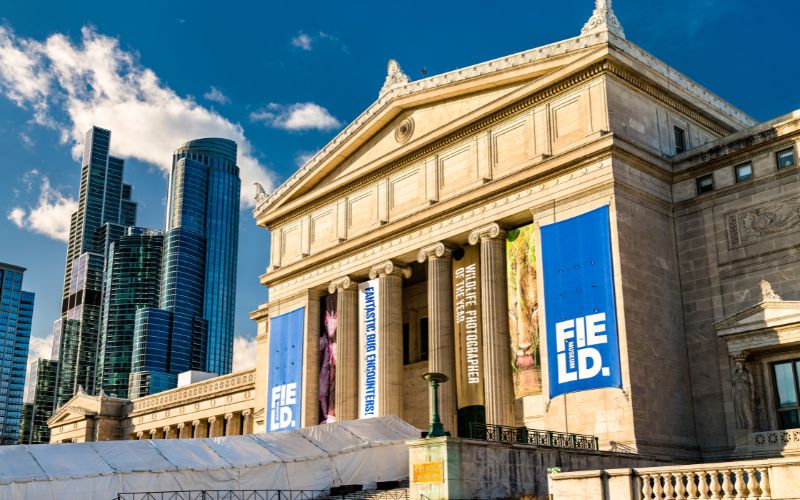
- Details
- By Jenna Kunze
As new federal law requirements went live last week, museums and institutions holding Native American human remains and artifacts across the country scrambled to understand and implement new changes. Native advocates say it's just the beginning.
On Jan. 9, three days before the new federal regulations went into effect, Chicago’s Field Museum covered several display cases containing cultural items from Native communities throughout the United States.
“Pending consultation with the represented communities, we have covered all cases that we believe contain cultural items that could be subject to these regulations,” the museum wrote in a statement. “The Field Museum does not have any Native American human remains on display.”
The move was to preempt the Native American Graves Protection and Repatriation overhaul that went into effect Friday, Jan. 12. The new rule, nearly three years in the making, is aimed at expediting a process that Congress intended to finish three decades ago: the total return of all Native human remains and their cultural objects held by museums and institutions across the country.
Passed by Congress in 1990, NAGPRA is a human rights law that legally compels museums and federal institutions that possess Native American human remains and associated funerary objects to catalog and return those ancestors and belongings within five years to their present-day tribal nations.
Since 1995, museums have reported a collection of more than 208,000 human remains. But in the past 33 years, not even half have been returned. Today, institutions still hold roughly 96,000 human remains, according to the government’s database.
Key changes to the law include: shifting the onus of initiating consultation from tribal nations to museums and institutions; requiring deference to the Indigenous knowledge of lineal descendants and tribes; eliminating the term “culturally unidentifiable” that’s kept ancestors and their belongings in museums’ possession for decades; and setting the clock for five years for museums and federal agencies to re-inventory their collections and consult with tribes for return.
Additionally, the new law will require museums and federal agencies to “require free, prior, and informed consent before any exhibition of, access to, or research on human remains or cultural items.” That part of the law change borrows language established in the early 2000s, the United Nations Declaration on the Rights of Indigenous Peoples, a non-binding human-rights standard.
“It’s freaking huge,” said Shannon O’Loughlin (Choctaw Nation), chief executive for the Association on American Indian Affairs, of the new language. “It's reminding institutions that they have new obligations with stricter requirements. So even though the Act has always held that institutions don't own these items, they can't just act however they want with our ancestors and items. This is the first time for this strong language.”
But O’Loughlin and others still feel the Field Museum is “missing the mark” when it comes to engaging tribal communities and understanding the heart of NAGPRA.
Although the Field Museum was the first institution to respond to the new law, they’ve been among the slowest to enact NAGPRA over the last three decades. Currently, the museum holds the third largest collection of Native ancestors in the country, with close to 1,300 ancestors and 964 of their burial objects, according to figures it previously reported to the National Park Service.
“If they really were wanting to get the word out that this is an important requirement that we all must follow, that’s a different way of saying it than the way they have in their press statement,” O’Loughlin said. “It's not a statement of protection of tribal rights. It's not put forward as a positive thing for tribes, but …as this abstract, nonsensical thing.”
Former Field Museum employee Debra Yepa-Pappan (Jemez Pueblo), who left her position after six years in June 2023, told Native News Online that it's disappointing that it took a change in law to compel the museum to do what’s right.
She remembered past instances of Indigenous visitors notifying museum staff that there were sacred items on display, such as a ceremonial mask in the Northwest Coast Hall, that were inappropriate for public viewing.
“It had to take a change in the law for [the Field Museum] to act on covering cases,” Yepa-Pappan said. “What that shows me is that there isn't confidence or acknowledgement that tribal knowledge is important and valid. I think there needs to be more understanding institutionally about why this is important to Native nations.”
Sunshine Bear (Winnebago Tribe), the repatriation officer for the Winnebago Tribe of Nebraska and a member of the repatriation task force for the Field Museum, said that she’s hopeful the changes to NAGPRA fill in the cracks tribal nations were falling through, such as the removal of the term “culturally unidentifiable” in the new law.
The majority of human remains in institutions today have been deemed “culturally unidentifiable” by the institutions that hold them, an unintended loophole in the law that has allowed museums decision-making authority to determine kinship and cultural affiliation, and therefore—in many cases—reject tribal evidence of oral history, geographic affiliation to the area where remains were unearthed, and other traditional knowledge.
“I'm hoping that [these changes] open some doors,” Bear told Native News Online. “This is a step forward, but it’s not solving everything. There’s definitely much more work to be done to ensure NAGPRA is working for tribes.”
Other institutions, such as the Illinois State Museum, are using the new regulations as a reset to make sure that tribal consultation is at the forefront of their work.
“We have been working to remove all [associated funerary objects] and human remains off display, that was done before I got here,” said Heather Miller (Wyandotte Nation), the museum’s director of tribal relations. Miller was hired in 2022 to build relationships with dozens of tribal nations the museum is undertaking consultation with in an effort to clear its collection of nearly 6,000 human remains and more than 30,000 burial objects, according to the federal database.
“I feel confident that the [items] we have on display are okay. However, I think that these new regs are asking us to take a step back and say: we as a museum see this as okay, but have our tribal partners deemed this as okay? That’s the next step.”
On Jan. 20, The Cleveland Museum of Art followed the Field Museum’s example and installed opaque covers on three display cases containing Native American artifacts while it initiated tribal consultation. Other museums, such as the American Museum of Natural History in New York City, got ahead of the NAGPRA update when it made policy changes in October that removed a lot of potentially sensitive items from exhibit.
Melanie O’Brien, who administers the National NAGPRA Program on behalf of the Secretary of the Interior, told Native News Online that her office has received a lot of questions on what museums need to do to comply with the new duty of care requirement.
In response, her office created a Duty of Care FAQ to guide museums in questions ranging from ‘what is a duty of care’ to explaining why consent is important and necessary.
O’Brien specifically pointed to the question: “Does our museum need to remove all human remains and potential cultural items from (the) exhibit?”
The answer, according to the FAQ, depends on a museum’s record of consultation and the type of item on exhibit.
“If, through consultation, an Indian Tribe agreed to putting an object in an exhibit, no action is required,” the sheet says. “ If, during past consultation, an Indian Tribe requested that the museum remove certain objects from the exhibit, but the museum refused to do so, the museum should remove or cover the objects as soon as possible. If the museum has human remains or cultural items in an exhibit but has never consulted on the human remains, objects, or general content of the exhibit, the museum should prioritize removal or covering of any human remains and funerary objects in particular. The museum should also initiate consultation on the human remains and funerary objects as quickly as possible to determine the preferred treatment of consulting parties.”
More Stories Like This
50 Years of Self-Determination: How a Landmark Act Empowered Tribal Sovereignty and Transformed Federal-Tribal RelationsTrump Veto Stalls Effort to Expand Miccosukee Tribal Lands
Oneida Nation Responds to Discovery Its Subsidiary Was Awarded $6 Million ICE Contracts
SRMT Child Support Enforcement Unit Delivers Holiday Food Boxes to Families
The Shinnecock Nation Fights State of New York Over Signs and Sovereignty
Help us defend tribal sovereignty.
At Native News Online, our mission is rooted in telling the stories that strengthen sovereignty and uplift Indigenous voices — not just at year’s end, but every single day.
Because of your generosity last year, we were able to keep our reporters on the ground in tribal communities, at national gatherings and in the halls of Congress — covering the issues that matter most to Indian Country: sovereignty, culture, education, health and economic opportunity.
That support sustained us through a tough year in 2025. Now, as we look to the year ahead, we need your help right now to ensure warrior journalism remains strong — reporting that defends tribal sovereignty, amplifies Native truth, and holds power accountable.
 The stakes couldn't be higher. Your support keeps Native voices heard, Native stories told and Native sovereignty defended.
The stakes couldn't be higher. Your support keeps Native voices heard, Native stories told and Native sovereignty defended.
Stand with Warrior Journalism today.
Levi Rickert (Potawatomi), Editor & Publisher


